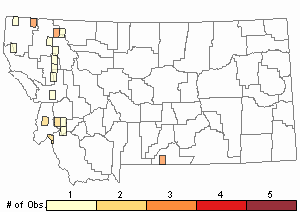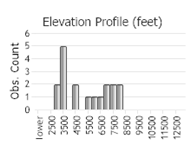View in other NatureServe Network Field Guides
NatureServe
Montana
Utah
Wyoming
Idaho
Wisconsin
British Columbia
South Carolina
Yukon
California
New York
Brown Hair Peatmoss - Sphagnum fuscum
Other Names:
Brown Peatmoss
General Description
Plants: Growing in tufts or hummocks (Crum and Anderson et al. 1981), thin, rigid and normally dense, deep russet. In shady areas or during first growth of season may be brown tinged with green. Capitulum level-topped and small (FNA 2007).
Stems and Stem Leaves: Stems russet. Stem leaves tongue-shaped, 0.8-1.3 mm in length, the widely rounded apex tattered to smooth, occasionally with a mucro or somewhat toothed (FNA 2007).
Branches and Branch Leaves: Branch stems green, 5-ranked to not ranked, long and thin to short and more solid, dimorphic, occurring in clusters of 2 wider, longer spreading and 1-2 narrower pendent branches. Branch leaves egg-shaped or tending toward lance-shaped, straight, 1.1-1.3 mm in length, cupped; apex strongly inrolled; margins smooth (FNA 2007).
Stem and Stem Leaf Cells: Stem cortical cells fine-walled, swollen, lacking both fibrils and pores. Hyaline cells of the stem leaves unevenly 4-sided, nonseptate or divided once (occasionally twice) with cross-walls, mostly lacking fibrils, largely reassimilated on the inner leaf surface and generally intact on the exterior surface (FNA 2007).
Branch and Branch Leaf Cells: Branch stems encompassed by 1 layer of swollen, fine-walled hyaline cells that lack fibrils, these occasionally in clusters of 1-pored retort cells. Hyaline cells of the branch leaves with numerous pores along the margins adjacent to the green cells on the convex leaf surface, the pores small distally, becoming larger proximally, and displaying on the concave surface big pores in the lower marginal areas of the leaves; green cells deltoid to trapezoidal in X-section, showing on both leaf surfaces, more widely so on the concave (inner) side, the end walls of the cells not great in depth (FNA 2007).
Phenology
Capsules ripen toward the end of summer (FNA 2007).
Diagnostic Characteristics
Notable morphological variations in this species include: stem leaves with apices smooth and curved to torn and flat; branches thin and unranked to obtuse and 5-ranked; and colors from pale to deep brown (FNA 2007).
Range Comments
North American Range
Canada: Present in all provinces and territories; USA: in the west from MT s to CO, w to the coastal states (unknown in NV), and in the northeastern states, bounded in the west by MN and IL, and in the south by IN, OH, WV, VA and NC (FNA 2007). Known in Montana from Carbon, Deer Lodge, Flathead, Glacier, Lake, Lincoln, Missoula, Ravalli, and Stillwater Counties (Elliott 2016).
Observations in Montana Natural Heritage Program Database
Number of Observations: 26
(Click on the following maps and charts to see full sized version)
Map Help and Descriptions
Relative Density

Recency



 (Observations spanning multiple months or years are excluded from time charts)
(Observations spanning multiple months or years are excluded from time charts)
Habitat
Found on top of older, less saturated hummocks (Crum and Anderson et al. 1981), on wet soil and peat (Elliott 2016), often in rain-fed mires and high mountain tops (developing mounds several feet tall), less often in slightly minerotrophic muddy ground and richer fens (FNA 2007).
Reproductive Characteristics
Dioicous. Sporophytes common (FNA 2007).
References
- Literature Cited AboveLegend:
 View Online Publication
View Online Publication Elliott, J.C. and A.K. Pipp. 2018. A Checklist of Montana Mosses (1880-2018). Updated 3 January, 2020. Montana Natural Heritage Program, Helena, Montana. 73 pp.
Elliott, J.C. and A.K. Pipp. 2018. A Checklist of Montana Mosses (1880-2018). Updated 3 January, 2020. Montana Natural Heritage Program, Helena, Montana. 73 pp.
- Additional ReferencesLegend:
 View Online Publication
View Online Publication
Do you know of a citation we're missing? Elliot, J. C. 1993. Second checklist of Montana mosses. Unpublished report. U.S. Forest Service, Region 1. Missoula, MT. 45 pp.
Elliot, J. C. 1993. Second checklist of Montana mosses. Unpublished report. U.S. Forest Service, Region 1. Missoula, MT. 45 pp. Lawton, E. 1971. Keys for the Identification of the Mosses on the Pacific Northwest. Reprinted from 'Moss Flora of the Pacific Northwest'. Published as Supplement No. 2 of the Journal of the Hattori Botanical Laboratory. Nichinan, Miyazaki, Japan. 66 pp.
Lawton, E. 1971. Keys for the Identification of the Mosses on the Pacific Northwest. Reprinted from 'Moss Flora of the Pacific Northwest'. Published as Supplement No. 2 of the Journal of the Hattori Botanical Laboratory. Nichinan, Miyazaki, Japan. 66 pp. Lawton, E. 1971. Moss Flora of the Pacific Northwest. Hattori Botanical Laboratory. Japan: Yamabuki-cho, Shinjuku-ku, Tokyo. 362 pages plus appendices.
Lawton, E. 1971. Moss Flora of the Pacific Northwest. Hattori Botanical Laboratory. Japan: Yamabuki-cho, Shinjuku-ku, Tokyo. 362 pages plus appendices.
- Web Search Engines for Articles on "Brown Hair Peatmoss"





